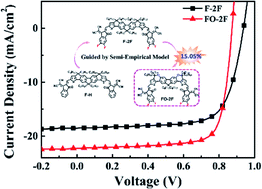The rational and effective design of nonfullerene acceptors guided by a semi-empirical model for an organic solar cell with an efficiency over 15%†
Abstract
Although much progress has been made in the field of organic photovoltaics (OPVs), the design of active layer materials is generally based on a trial-and-error approach. It is still a challenge to rationally design active layer materials to further improve OPV performance. Herein, guided by a semi-empirical model that we have proposed, two new small-molecule acceptors, named F-2F and FO-2F, were designed and synthesized based on the acceptor F-H. F-2F, having a difluoro-substituted end group, showed absorption red-shifted relative to that of F-H, but still far from the range required in the semi-empirical model. Thus, we performed subtle molecular optimization by inserting an oxygen atom into the backbone of F-2F to design FO-2F, which exhibited much greater red-shifted absorption, close to the preferred absorption range of the semi-empirical model. When blended with the donor polymer PM6, an OPV device based on FO-2F achieved an impressive PCE of 15.05% with a Voc of 0.878 V, a Jsc of 22.26 mA cm−2 and a notable FF of 0.77. Both the Voc and Jsc values were within the predicted range of the model. These results showed the FO-2F molecule to be a new example of an acceptor yielding a PCE greater than 15%, an achievement previously restricted nearly entirely to the Y6 series.



 Please wait while we load your content...
Please wait while we load your content...